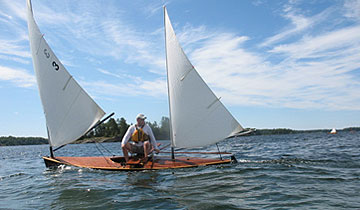Sailing Canoes
Upon locating and recovering a decked sailing canoe from the woods north of Gananoque, a new experience in canoes was catalyzed. It set into motion a period of research and not so much information, as I began to delve into a sport and pastime that had begun to decline in popularity over 50 years ago, however had hung in and evolved into the 10square meter class, or international canoe, as it is known today.
a personal fascination

As these modern, sloop rigged planing hulls trace their origins directly to the canoes of the late 1800s, as they evolved into ever faster and more technical racing machines. Rather than canoes with sails, which are also a great deal of fun, these racing machines very quickly bore little resemblance to paddling canoes. With the introduction of several features such as a Norwegian tiller and hiking seat, they were now capable of being driven by up to and beyond 90square feet of sail. Eventually arriving at a standard of 16feet by 30inches, and 90 feet of sail on two masts, they raced almost unchallenged until the 1930s when international competition from Britain when designs by Uffa Fox soundly defeated the Americans, leading to new class rules for international canoes.
Researching The Boat

I now had a boat requiring restoration, but wanted to get out on the water and had yet to experience sailing one. Enter John Summers who, while at the Antique Boat Museum in Clayton, New York, lofted a hard chined 16/30 and developed the boat for stitch and glue construction, thereby making them available to those wishing to sail one of these exciting boats. Previously, the only way to have one was through a costly acquisition and restoration of an original, if one could be found, or to commission a custom build of one.

I participated in the first build course in Clayton, NY where 5 such boats were initially built by those interested, and as plans have become available more are showing up each year, leading to a revival of sorts of an early class of racing not seen since the years leading up to the 1930s.
Of course I would be pleased to discuss the building of one for anyone wishing to commission one, but for now if you see one on the water don't be shy to ask for a ride; just be sure you are ready for a swim.
